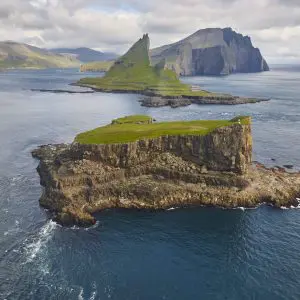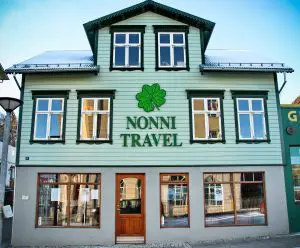Eysturoy
Learn More About Eysturoy
 Eysturoy is the second-largest island, shaped by mountains, fjords, and quiet villages that seem to belong to another time. Many Faroese people see Eysturoy as the country’s soul, where everyday life still follows the rhythm of the sea, the land, and the ever-changing weather.
Eysturoy is the second-largest island, shaped by mountains, fjords, and quiet villages that seem to belong to another time. Many Faroese people see Eysturoy as the country’s soul, where everyday life still follows the rhythm of the sea, the land, and the ever-changing weather.
Exploring Eysturoy will surely bring you to places filled with character and history. The village of Gjógv is perhaps best known for its deep gorge and natural harbor, which have sheltered boats for centuries. Because of the natural surroundings, it is a favorite spot for walkers and photographers. Further north lies Eiði, where the views stretch across the ocean towards the striking sea stacks known as Risin og Kellingin. According to local legend, these rocks are the remains of a giant and his wife, forever frozen in stone.
Eysturoy offers some of the best hikes for outdoor enthusiasts in the islands. Slættaratindur, the highest mountain in the Faroes, rises here. The climb is demanding but unforgettable, and on a clear day, you can see almost every corner of the archipelago from its summit.
Everyone who plans to explore Eysturoy will find a perfect activity, as the island’s winding roads reveal stunning scenery with every turn. Waterfalls tumble down cliffs, sheep roam freely across green hills, and small settlements invite you to stop and enjoy local hospitality. Traditional dishes often feature freshly caught fish, Faroese lamb, or even home-baked bread that tastes of simple but strong traditions.
Eysturoy is also home to the stunning Hvannhagi valley and Lake Toftavatn, which are perfect for nature lovers who enjoy peaceful walks and birdwatching. So, plan your day or two to see this unique place in the Faroe Islands!
Our Atlantic Neighbors: Travel Stories, Folklore & Hidden Gems in the Faroe Islands
Discover the Faroe Islands by Car: A Local’s Guide to Self-Drive Tours
Why Coolcations Are the Future of Travel: Iceland, the Faroe Islands, and Greenland Should Top Your List!
Velkomin!
How We Will Create Your Lifetime Journey: Best Self-Drive Tours in Iceland and the Faroe Islands
Most Common Questions About Eysturoy in the Faroe Islands
What makes Eysturoy one of the best places to visit in the Faroe Islands?
Eysturoy is known mainly for its stunning mountains, deep fjords, and picturesque villages. The island is also rich in folklore and traditions, allowing visitors to enjoy dramatic landscapes and authentic Faroese culture. Its mix of nature, history, and daily life makes it one of the most memorable parts of the archipelago. Also, all the popular places are easily accessible from Tórshavn.
Which villages should I visit on an Eysturoy tour?
Gjógv, with its gorge and natural harbor, is one of the most visited villages. Eiði is another highlight, offering expansive sea views and access to famous landmarks. Fuglafjørður, a lively town on the east coast, is perfect for exploring local shops and cultural life. Smaller places such as Oyndarfjørður and Funningur are also worth a stop.
Can I hike the highest mountain in the Faroe Islands on Eysturoy?
Yes, the island is home to Slættaratindur, the tallest peak in the Faroe Islands. The climb takes a few hours and requires good walking shoes, but no special equipment. On clear days, hikers are rewarded with views stretching across most islands.
Are guided tours available on Eysturoy?
Guided tours are offered throughout the year, covering everything from hiking and sightseeing to cultural visits. Local guides share knowledge of the land and tell stories that add depth to the experience. A tour with a guide often opens doors to places and traditions not found in guidebooks.
What is the best time of year to visit Eysturoy?
The summer months of June, July, and August provide long days and mild weather, perfect for hiking and outdoor activities. Spring and autumn bring quieter surroundings and dramatic light, ideal for photographers. Winter shows a different side of Eysturoy, with snow on the peaks and a peaceful atmosphere.
How do I reach Eysturoy from Tórshavn?
Eysturoy is well connected to the capital. You can drive across the bridge from Streymoy or take the modern Eysturoy Tunnel, which makes travel quick and straightforward. The journey from Tórshavn usually takes under an hour.
What are Risin og Kellingin and why are they famous?
Risin og Kellingin are two sea stacks near Eiði, rising high above the waves. Local legend tells of a giant and his wife who were turned to stone while trying to pull the Faroe Islands towards Iceland. The story and the natural beauty of these rocks make them a highlight on any Eysturoy itinerary.
Can I see wildlife on Eysturoy tours?
Yes, birdlife is one of the great attractions of Eysturoy. Gjógv and the surrounding cliffs are popular spots during the summer to see puffins and other seabirds. The waters around the island are also rich in marine life, and seals or even whales can sometimes be spotted.
Are Eysturoy tours suitable for families?
Families can enjoy many parts of Eysturoy without difficulty. Easy hikes, scenic drives, and visits to colorful villages are family-friendly. Children often enjoy the open landscapes, the sight of free-roaming sheep, and the chance to explore nature safely.
What local food can I try during an Eysturoy tour?
Fresh fish, slow-cooked lamb, and traditional Faroese bread are often part of the experience. Some tours include meals with local hosts or stops at restaurants that focus on traditional recipes. Eating on Eysturoy is a cultural experience and a chance to taste fresh island ingredients.
How long should I plan to spend on Eysturoy?
It is possible to see the main highlights in a single day, but two to three days give you time to enjoy the villages, hikes, and cultural visits at a relaxed pace. Staying overnight allows you to see the island in different light and weather, which is part of its charm.
Are there cultural experiences included in Eysturoy tours?
Yes, many tours include visits to historic churches, old farmhouses, or places tied to local legends. Guides often share stories passed down through generations, giving travelers insight into Faroese traditions. These cultural stops visit Eysturoy, which is more than just a scenic trip.
What should I wear on an Eysturoy tour?
The weather changes quickly in the Faroe Islands, so dressing in layers is essential. Even in summer, a waterproof jacket, sturdy walking shoes, and warm clothing are recommended. In winter, gloves, hats, and thicker layers are essential for comfort.
Why choose a guided tour instead of traveling alone on Eysturoy?
A guided tour gives you local insight and helps you make the most of your time on the island. Guides know the weather, the safe routes, and the hidden spots that most visitors would miss. Traveling with a guide also adds cultural depth, as you hear stories and traditions directly from Faroese locals.












